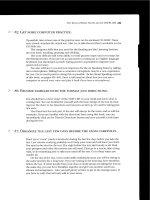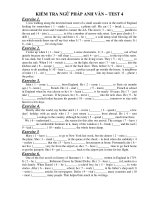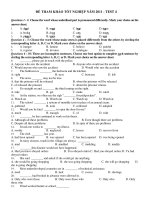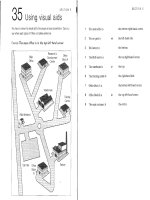Education skill test 4 ppt
Bạn đang xem bản rút gọn của tài liệu. Xem và tải ngay bản đầy đủ của tài liệu tại đây (87.02 KB, 6 trang )
or a credential based upon the completion of a
teacher-preparation program outside of California
may obtain an initial teaching credential without
meeting the CBEST requirement. All such candidates
must pass the CBEST, however, during the first year of
validity of the initial credential.
Oregon
In Oregon, you may be granted a two-year (24-month)
exemption from the CBEST requirement if you have
not yet passed the CBEST, but are otherwise qualified
for licensure.
The CBEST waiver is only granted upon request
of the employing school superintendent or school
board in the event that (1) attempts were made to hire
a properly licensed educator, but were unsuccessful,
and that (2) the position is necessary for the school to
operate normally. However, exemption can be granted
without district request to candidates from states with
reciprocral agreements in Oregon—such an exemp-
tion is nonrenewable. For further licensure, passing
scores on the CBEST must be presented by the candi-
date.
What is the CBEST Like?
What Sorts of Questions Does
the CBEST Ask?
The CBEST exam is comprised of three separate sec-
tions: (1) Reading, which consists of 50 multiple-
choice questions; (2) Mathematics, consisting of 50
multiple-choice questions; and (3) Writing, which
consists of two essay subjects.
Questions in the Reading section are derived
from two important skill areas: critical thinking/argu-
ment analysis, and research/comprehension. Drawn
from a variety of fields, such as humanities, the social
sciences, consumer affairs, or health, CBEST questions
are based on passages that vary in degree of difficulty
and complexity, and are designed to assess the test-
taker’s ability to evaluate and comprehend the infor-
mation presented. Some passages are longer (200
words or more); some are shorter (about 100 words).
Some may be statements of one or two sentences,
while others may even be tables or graphs. Every ques-
tion is based on a particular passage, table, or graph.
None require outside knowledge, and all of the ques-
tions can be answered on the basis of the analysis and
comprehension of the information provided.
The Mathematics section is mostly comprised of
questions—presented as word problems—that evalu-
ate the test-taker’s ability to solve mathematical prob-
lems. The questions asked are designed to assess three
major skill areas: estimation, measurement, and sta-
tistical principles; computation and problem solving;
and numerical and graphic relationships.
The Writing section is comprised of two essay
subjects—both of which the test-taker must respond
to—and are designed to assess your ability to write
coherently, authoritatively, and persuasively. In one of
the essays, you will be asked to analyze a situation or
statement, while the other requires a written response
relating to a personal experience. Your essays must be
written in your own words, and you must write only
on the topics presented. All points in both essays must
address the assigned topic, and should be aimed at a
specific audience. Essay responses must support any
assertions with specific, relevant details and examples.
The key to success here is to stay specific—do not
digress! For more detailed information on what it takes
to write a fantastic essay, see the section on Writing in
the CBEST Mini-Course (Chapter 4). The criteria for
scoring the CBEST essays is found at the end of Chap-
ter 5; many tips for successfully writing a “4” (Pass)
essay are also found there.
How Long Does the CBEST Take?
When you take the CBEST, you have a total of four
hours in which to complete the three separate sections.
–WHAT IS THE CBEST?–
3
You do not need to complete all three sections in one
four-hour sitting. (The exception to this rule is the
CBEST Writing section. The essays cannot be split up;
both essays in the section must be completed at one
sitting. They cannot be administered separately.) You
may choose to concentrate on one or two sections at
any given test administration, reregister, and then work
solely on a third section at a later date. If you choose
this latter option, take note that regardless of the num-
ber of sections you are taking at any given sitting—
even just one—the entire test fee is required, and you
will be required to reregister each time.
If you choose to do the whole test in one four-
hour sitting, be aware that you don’t have to do the sec-
tions in any particular order. The test is not timed
according to individual sections, so you may want to
get the hardest sections out of the way while you are
fresh and still have your wits about you.You may want
to do the essays first, because you can guess on the
other sections if you run out of time. This may work to
your advantage, since no points are deducted—there is
no penalty—for guessing.
Doing the practice tests in this book, or
taking advantage of the practice questions on the
CD-ROM—which has the advantage of ease of use,
and automatic, immediate test scores—will help you
decide what is the best course of action for you.
What Should I Bring
to the Test Site?
Because of test security, few materials are allowed in
the test-taking room. You will need to bring the fol-
lowing materials:
■
Your admission ticket
■
Several sharpened #2 pencils with erasers
■
A current, government-issued photo ID with sig-
nature
Some other materials NOT permitted in the testing
room (unless previously authorized or provided by
NES®) include:
■
Scratch paper
■
Calculators
■
Dictionaries
■
Cellular phones or other communication devices
■
Alarm watches
■
Visitors
Bringing any prohibited materials to a test adminis-
tration may result in your score(s) being voided. If you
have questions or require more detailed information
on the day of the test, call CBEST at (916) 928-4001,
from 7:30
A.M. to 3:30 P.M. PST (Pacific standard time).
What is a Passing Score?
To pass the CBEST, you must pass all three sections of
the CBEST. Raw scores can range from 1–50, which are
then converted to scaled scores ranging from 20–80.
The passing scaled score on each section of the test is
41. You must achieve a minimum total score of 123 for
the three sections to pass (the sum of the Reading,
Writing, and Mathematics scaled scores).
It is possible to pass the CBEST even if your
scaled score in one or two sections is as low as 37, pro-
viding your total scaled score is 123 or higher. (Take
note that regardless of how high your total scaled score
might be, you will not pass the CBEST if, in any sec-
tion, you get a scaled score lower than 37.)
What Do My Scores Mean?
You should receive your scores four to six weeks after
the test date. For each section—Reading, Math, and
Writing—your scores will announce whether or not
you passed the section and will suggest areas within
each section that you may need to study. The score
–WHAT IS THE CBEST?–
4
report will also include the highest score you have
obtained so far in that section. A passing score on any
part of the test means that you will not have to take
that part of the CBEST again!
Retaking the Test
What happens if you fail, or fail to finish, one or more
sections of the CBEST? Don’t worry.You don’t need to
pass all three sections at the same time, nor is there a
limit to the number of times you can retake any or all
sections of the CBEST to achieve a passing score. Once
a section is passed, you need never take that section
again. However, you may wish to repeat a section
already passed to achieve a higher score, if that higher
score can help you reach the total score required to
pass the entire CBEST.
Once the entire CBEST has been passed, you will
never have to take it again. You only need to pass the
entire CBEST once to qualify for the initial issuance or
future renewal of any teaching credential.
How Do I Register for the
CBEST?
When is the Test Given?
The CBEST is offered six times a year, once every two
months, at various locations throughout California
and Oregon. It is usually given on the first or second
Saturday of the months of February, April, June,
August, October, and December.
How Do I Register?
There are three periods of registration: Regular, Late,
and Emergency; and three registration options: mail,
phone, and Internet.
For Regular Registration, you should register at
least one month prior to the applicable test date. You
can register either by mail or the Internet; phone reg-
istration is not available for this option. If registering
by mail, applications must be postmarked by the Reg-
ular Registration deadline, or received by the Late Reg-
istration deadline. If registering online, applications
should be completed by 5:00
P.M. PST on the Regular
Registration deadline.
For Late Registration (up to approximately two
weeks prior to the test date), a late fee applies, and reg-
istration is granted on a space-available basis only. You
may register by mail, phone, or Internet. If registering
by mail, your completed materials must be received on
or before the Late Registration deadline. If you regis-
ter by phone, you must call before 5:00
P.M. PST on the
Late Registration deadline. If registering online, your
application must be finished by 5:00
P.M. PST on the
Late Registration deadline.
For Emergency Registration (up to four days
prior to the test), an additional late fee is charged, and
registration is granted on a space-available basis only.
You can register either by phone or Internet; mail reg-
istration is not available for this option. If you register
by phone, you must call before 5:00
P.M. PST on the
Emergency Registration deadline. If registering online,
your application must be finished by 5:00
P.M. PST on
the Emergency Registration deadline. Emergency Reg-
istration is limited to ten test areas in California, and
one in Oregon.
Alternative testing arrangements can be made for
either religious reasons or for special needs accommo-
dations. All requests for alternative testing arrange-
ments must be postmarked by the Regular Registration
deadline for the test date applied for. Be advised that
registration deadlines are strictly enforced—and there
are NO exceptions!
Whom Do I Contact with
Questions?
For any questions, or more detailed information
regarding registration procedures, test dates, or loca-
tions, contact:
–WHAT IS THE CBEST?–
5
CBEST PROGRAM
National Evaluation Systems, Inc.
P.O. Box 340880
Sacramento, CA 95834-0880
916-928-4001
Telephones are open 9:00
A.M.–5:00 P.
M.PST
Monday–Friday, excluding holidays; Saturday test
dates only: 7:30
A
.M.–3:30 P.M.PST
Facsimile: 916-928-6110 (note: Registration forms are not
accepted by fax)
Automated Information System is available 24 hours daily:
800-262-5080
CBEST website: www.cbest.nesinc.com
Telecommunications Device for the Deaf (TDD):
916-928-4191
Telephones are open from 9:00
A.M.–5:00 P.M. PST,
Monday–Friday, excluding holidays; 7:30
A.M.–3:30 P.M.
PST, Saturday test dates only.
For Late and Emergency Registration services:
916-928-4001
During phone-in registration periods, telephones are open
from 9:00
A.M.–5:00 P.M. PST, Monday–Friday,
excluding holidays.
For more detailed information about CBEST policies
in general, contact:
CALIFORNIA COMMISSION ON
TEACHER CREDENTIALING (CCTC)
Attention: CBEST Project Officer
P.O. Box 944270
Sacramento, CA 94244-2700
916-445-7254; If outside the 916 area code, call toll free:
888-921-2682.
Telephones are open 8:00
A.M.–5:00 P.M.PST,
Monday–Friday, excluding holidays. (Automated
Information System is available 24 hours daily.)
CCTC website: www.ctc.ca.gov
(Please include postal address in any e-mail messages.)
OR
Oregon Teacher Standards and Practices
Commission
465 Commercial Street NE
Salem, OR 97310
503-378-3586
For more detailed information about CBEST test
requirements in California and Oregon, or other
questions:
■
For college or university program admission in
California, you can contact the department or
school of education that you are interested in.
■
For employment in California, you can contact
the county school district’s credentialing depart-
ment, or office of education.
■
For employment, or college or university Com-
mission-approved program admission in Oregon,
call the personnel office, or the Education Service
District, of the school district you are interested
in, the Dean of Teacher Education at the univer-
sity or college you are interested in, or the Oregon
Teacher Standards and Practices Commission.
Don’t Panic
The CBEST probably will not be the hardest test you
will be faced with in your life. For many, it will require
some careful and thoughtful preparation. If you have
completed four years of college, you will be able to pass
the CBEST. Some of you may need extensive review
first, and some of you may need private tutoring. If
you are willing to put forth the effort, passing is
possible!
–WHAT IS THE CBEST?–
6
F
irst, the bad news: Taking the CBEST is no picnic, and neither is getting ready for it. Your future
career as a teacher depends on a good score, and there are all sorts of pitfalls that can keep you from
doing your best on this all-important exam. Here are some of the obstacles that can stand in the way
of your success:
■
Being unfamiliar with the format of the exam
■
Being paralyzed by test anxiety
■
Leaving your preparation to the last minute
■
Not preparing at all
■
Not knowing vital test-taking skills: how to pace yourself through the exam, how to use the process of
elimination, and when to guess
■
Not being in tip-top mental and physical shape
■
Arriving late at the test site, having to work on an empty stomach, or shivering through the exam because
the room is cold
CHAPTER
LearningExpress
Test Preparation
System
CHAPTER SUMMARY
Taking the CBEST can be difficult. If you want to achieve a good
score, it demands a lot of preparation. And you need that good score
if you want to be certified! The LearningExpress Test Preparation Sys-
tem, developed exclusively for LearningExpress by leading test
experts, gives you the attitude and discipline you need to be suc-
cessful.
2
7
What’s the common denominator in all these
test-taking pitfalls? One word: control. Who’s in con-
trol, you or the exam?
Now the good news: The LearningExpress Test
Preparation System puts you in control. You only have
to pass the CBEST once, and in nine easy-to-follow
steps, you will learn everything you need to know to
make sure that you do. Why? Because you will be in
charge of your preparation and and your performance
on the exam. Other test-takers may let the test get the
better of them; other test-takers may be unprepared or
out of shape, but not you. Yo u will have taken all the
steps you need to take to get a good score on the
CBEST.
Here’s how the LearningExpress Test Preparation
System works: Nine easy steps lead you through every-
thing you need to know and do to get ready to master
your exam. Each of the steps listed below includes both
reading about the step and one or more activities. It’s
important that you do the activities along with the
reading, or you won’t be getting the full benefit of the
system. Each step tells you approximately how much
time that step will take you to complete.
We estimate that working through the entire sys-
tem will take you approximately three hours, though
it’s perfectly ok if you work faster or slower than the
time estimates assume. If you can take a whole after-
noon or evening, you can work through the whole
LearningExpress Test Preparation System in one sit-
ting. Otherwise, you can break it up, and do just one or
two steps a day for the next several days. It’s up to
you—remember, you’re in control.
Step 1: Get Information
Time to complete: 60 minutes
Activities: Use the suggestions listed here to find out
about the content of your exam.
Knowledge is power. The first step in the LearningEx-
press Test Preparation System is finding out everything
you can about the CBEST. Once you have your infor-
mation, the next steps in the LearningExpress Test
Preparation System will show you what to do with it.
Part A: Straight Talk About the
CBEST
Why do you have to take this exam? The states of Cal-
ifornia and Oregon require the CBEST for all appli-
cants for a first-time teaching or service credential.
Unless the applicant already has a California teaching
credential or is exempted, he or she must take the
CBEST in order to be issued—or obtain renewal of—
an Emergency Permit. (This latter requirement does
–LEARNINGEXPRESS TEST PREPARATION SYSTEM–
8
Step 1. Get Information 60 minutes
Step 2. Conquer Test Anxiety 20 minutes
Step 3. Make a Plan 25 minutes
Step 4. Learn to Manage Your Time 10 minutes
Step 5. Learn to Use the Process of Elimination 20 minutes
Step 6. Know When to Guess 20 minutes
Step 7. Reach Your Peak Performance Zone 10 minutes
Step 8. Get Your Act Together 10 minutes
Step 9. Do It! 5 minutes
Total 3 hours









